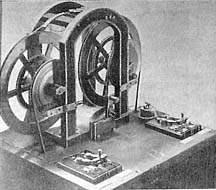Magnetic sound recording tape was first developed by Danish inventor Valdemar Poulsen in the 1890s. He used a solid band of steel as the medium for one version of his Telegraphone, which worked well enough but was expensive and heavy. Solid-steel tape continued to be used through the end of the 1930s by some manufacturers, and steel in the form of thin wires was popular for a few years in the late 1940s and early 1950s.
However, another approach was to used a non-magnetizable base strip, such as paper or plastic, coated with a mixture that included fine powder made from magnetizable materials. The German company I. G. Farben improved such coated tapes and introduced them for use with the AEG Magnetophon in the 1930s. Following World War II, the I. G. Farben process was transferred to England and the United States and improved. It was this coated tape that dominated the market from 1945 to the present.
The photos below show some of the major operations needed to make recording tape, and they represent the state of the art around 1955.
Gamma-ferrous oxide (a special form of iron oxide) in the form of very fine, elongated particles was first put in ball mills and mixed with binders, plasticizers (plastic softeners), and other chemicals. The ball mill is the large container at the top of the picture. Inside are large steel balls that pulverize and mix the ingredients.
The liquid mixture was stored in tanks until it was delivered to the coater
The tape coater, a piece of equipment similar to that used in printing to apply special coatings to paper, spreads a thin layer of the oxide mixture onto an acetate or Mylar plastic film about three feet wide. The wet tape is subjected to a strong magnetic field to align the oxide particles, which are long and thin in shape. The tape is also force-dried and sometimes polished on the coating line. Finished tape can be seen coming out of the machine in the right foreground.





